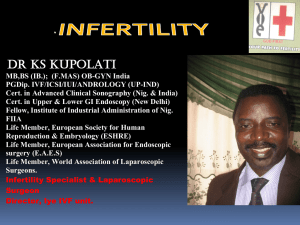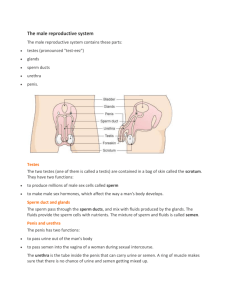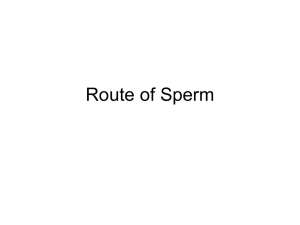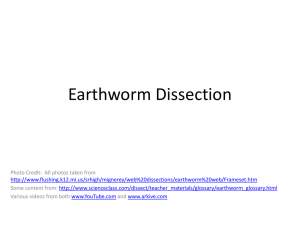Comparisons between long and short sperm males Sperm quality
advertisement
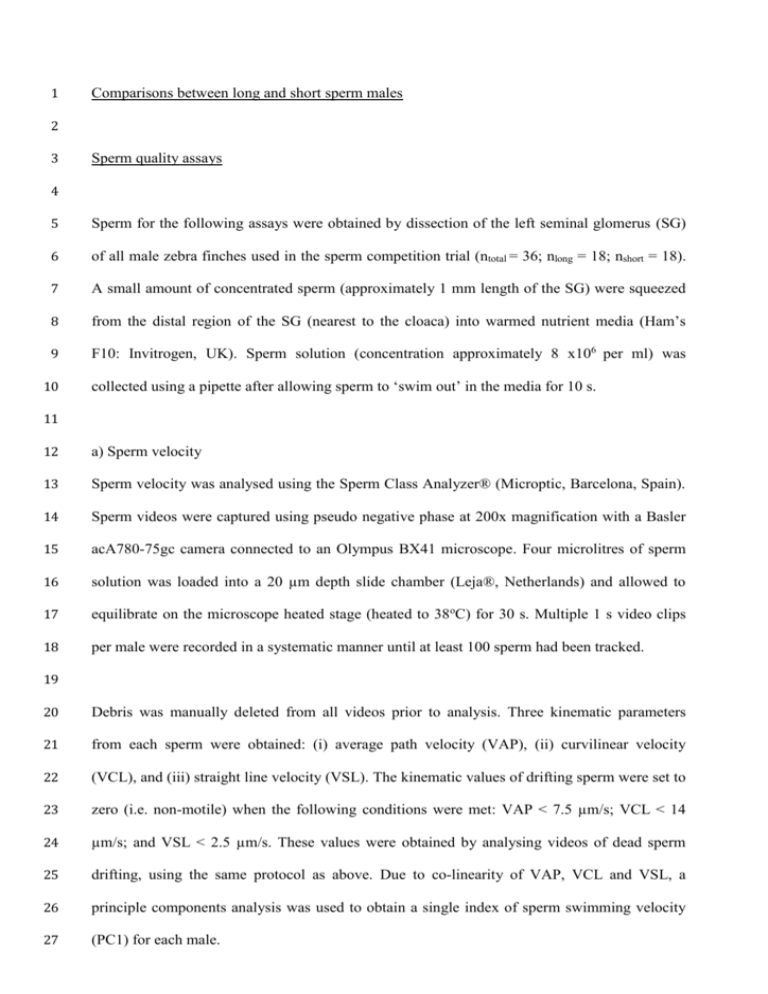
1 Comparisons between long and short sperm males 2 3 Sperm quality assays 4 5 Sperm for the following assays were obtained by dissection of the left seminal glomerus (SG) 6 of all male zebra finches used in the sperm competition trial (ntotal = 36; nlong = 18; nshort = 18). 7 A small amount of concentrated sperm (approximately 1 mm length of the SG) were squeezed 8 from the distal region of the SG (nearest to the cloaca) into warmed nutrient media (Ham’s 9 F10: Invitrogen, UK). Sperm solution (concentration approximately 8 x106 per ml) was 10 collected using a pipette after allowing sperm to ‘swim out’ in the media for 10 s. 11 12 a) Sperm velocity 13 Sperm velocity was analysed using the Sperm Class Analyzer® (Microptic, Barcelona, Spain). 14 Sperm videos were captured using pseudo negative phase at 200x magnification with a Basler 15 acA780-75gc camera connected to an Olympus BX41 microscope. Four microlitres of sperm 16 solution was loaded into a 20 µm depth slide chamber (Leja®, Netherlands) and allowed to 17 equilibrate on the microscope heated stage (heated to 38oC) for 30 s. Multiple 1 s video clips 18 per male were recorded in a systematic manner until at least 100 sperm had been tracked. 19 20 Debris was manually deleted from all videos prior to analysis. Three kinematic parameters 21 from each sperm were obtained: (i) average path velocity (VAP), (ii) curvilinear velocity 22 (VCL), and (iii) straight line velocity (VSL). The kinematic values of drifting sperm were set to 23 zero (i.e. non-motile) when the following conditions were met: VAP < 7.5 µm/s; VCL < 14 24 µm/s; and VSL < 2.5 µm/s. These values were obtained by analysing videos of dead sperm 25 drifting, using the same protocol as above. Due to co-linearity of VAP, VCL and VSL, a 26 principle components analysis was used to obtain a single index of sperm swimming velocity 27 (PC1) for each male. 28 b) Sperm morphology, and percentage of sperm with normal morphology 29 Five microlitres of sperm solution was fixed in 5% formalin. Ten morphologically normal, 30 undamaged sperm were photographed using light microscopy (Leitz Laborlux S) at 400x and 31 an Infinity 3 camera (Luminera Corporation) for males involved in the experiment. Although 32 measuring only five sperm captures the majority of the morphological variation in a male’s 33 sperm sample [1], measuring ten sperm ensured that we obtained virtually all sperm 34 morphological variation. This was crucial because this sperm length data set provided the range 35 of lengths of each sperm component (e.g. midpiece, total length) that were used to distinguish 36 between long and short sperm on the outer perivitelline layer of eggs. The length of all sperm 37 components was measured directly from the photographs (i.e. ‘simple’ midpiece length etc.) to 38 the nearest 0.01 µm using ImageJ [2]. Observer measurement repeatability [3] was high for all 39 sperm components (head: F = 74.9: r = 0.97; midpiece: F = 1390.1: r = 0.99; tail: F = 616.3: r = 40 0.98). Two hundred randomly chosen sperm were then scored as having normal or abnormal 41 morphology, and the proportion of sperm with a normal morphology (no damage to any 42 component part or visible morphological abnormalities) was calculated. 43 44 c) Sperm viability 45 Sperm viability was estimated using a membrane integrity assay (Live/Dead Viability kit 46 (Invitrogen™)), prepared as follows: 1 µl of 2.4 mM propidium iodide (PI) was diluted using 47 200 µl PBS. One microlitre of 1 mM SYBR14 was diluted with 10 µl of dimethyl sulphoxide 48 (DMSO). A small sample (0.5 µl) of sperm solution was collected and placed on a microscope 49 slide. Three microlitres each of PI and SYBR14 were incubated with the sperm sample in the 50 dark for 5 minutes. Using a fluorescent microscope (Leica DMBL) and 200x magnification, a 51 minimum of 200 sperm were scored as having an ‘intact’ membrane or an ‘damaged’ 52 membrane according to the colour of the nucleus (green = intact membrane, red = damaged 53 membrane). The proportion of sperm with an intact membrane was calculated. 54 55 d) Sperm longevity and sperm concentration 56 The remaining sperm in the distal region of the left SG were carefully squeezed into 15 µl of 57 media (at room temperature), a process that took approximately 5 minutes per bird. The 58 concentrated sperm solution was divided into 1 µl aliquots, diluted with 3 µl of media and 59 incubated at 38oC in a water bath. Every 15 minutes, an aliquot was diluted with warm media 60 (38oC) to a concentration of approximately 8x106 sperm per ml and loaded into a slide 61 chamber. Five video clips per time point were recorded and the average proportion of motile 62 sperm calculated. The duration of motility (in minutes) of each sperm sample was recorded at 63 the time that all sperm were immotile. 64 65 A single aliquot was used to calculate the concentration of sperm in the distal region of the SG. 66 Ninety-nine microlitres of 5% formalin was added to the sample before vortexing for 20 s 67 (Autovortex mixer SA2) to disperse sperm clumps. Twenty microlitres of the sample was 68 loaded onto an Improved Neubauer chamber. All sperm were counted across the both grids and 69 an average of the two grids was calculated, giving the number of sperm found in a volume of 70 0.9 mm3. The sperm concentration per millilitre (ml), corrected for dilution, was calculated 71 using the following formula: 72 73 Sperm concentration ⋅ 106 (ml) = (( sperm count 0.9 ) ⋅ 1000) ⋅ 100 74 75 76 Sperm quality between the specific pairs of males used in the sperm competition experiments 77 (one long sperm and one short sperm male) were analysed in R v 2.15.1 [4], using paired t tests, 78 to establish whether there was any systematic bias in any measure of sperm quality that might 79 influence the outcome of sperm competition. 80 The sperm quality of the long and short sperm males was similar in terms of the proportions of 81 viable, morphologically normal and motile sperm (table S1). The distal region of the SG of 82 short sperm males contained more sperm compared to the long sperm males, but this trend was 83 non-significant. Long and short sperm males differed in sperm length (e.g. head, tail and total 84 length), and sperm swimming velocity, such that long sperm swam faster than short sperm. 85 Interestingly, mean midpiece length was similar between the long and short sperm male pairs, 86 although there was less variation in the midpiece length of short sperm compared to long 87 sperm. 88 89 Testes mass 90 The left testes of males were removed by dissection, cleaned with phosphate buffered saline 91 (PBS), blotted dry and weighed to the nearest 0.001 g using a Sartorius Acculab balance. The 92 effect of male selection line on left testes mass was analysed using a linear model in the base 93 package in R [4], with male selection line (long or short) as a fixed effect. Body mass was 94 included as a covariate. Left testes mass only was used in the analysis because sperm from the 95 left SG only was collected for the sperm quality analyses. 96 Short sperm males had a lower left testes mass compared to long sperm males (table S2); on 97 average, the testes of the short sperm males were 0.005 g lighter (18%). It is not possible to 98 extrapolate the total number of sperm available for insemination from the mass of a single 99 testis. However, if smaller testes produce fewer sperm, this could suggest that males with 100 smaller testes may be disadvantaged in a competitive scenario. Interestingly, in this study, the 101 short sperm males tended to store more sperm (although not significantly more) in the distal 102 region of the left SG than long sperm males (table S1). At the very least, this data indicates that 103 the lighter testes of the short sperm males were not a disadvantage during sperm competition. 104 105 106 107 108 109 110 111 112 113 114 115 Table S1. Results of the sperm quality comparisons between pairs of long and short sperm males used in the sperm competition experiments. Only measures of sperm length (with the exception of midpiece length) and swimming velocity differed within the pairs of males. Mean ± S.D Sperm quality assay Test statistic Long Short t p n Proportion of motile sperm1 0.87 ± 0.12 0.88 ± 0.14 0.03 0.98 17 Proportion of normal sperm 0.74 ± 0.08 0.72 ± 0.14 0.21 0.84 17 Proportion of viable sperm 0.74 ± 0.11 0.75 ± 0.14 -0.72 0.48 17 107.70 ± 95.27 142.02 ± 117.60 -1.22 0.24 17 0.63 ± 0.24 0.60 ± 0.29 0.60 0.55 17 All immotile (min) 113.33 ± 50.47 135.5 ± 75.75 -1.35 0.19 17 Total population 1.51 ± 0.79 0.50 ± 0.71 6.32 <0.0001 17 Fastest 10% 3.62 ± 0.76 2.10 ± 0.72 10.39 <0.0001 17 Fastest single sperm 4.27 ± 0.75 2.95 ± 0.97 5.00 0.0001 17 Head 11.42 ± 0.58 10.72 ± 0.43 4.34 0.0005 17 Midpiece 29.75 ± 5.37 31.06 ± 1.66 -1.20 0.25 17 Tail 33.56 ± 6.42 14.77 ± 2.43 10.97 <0.0001 17 Total length 74.73 ± 2.19 56.55 ± 1.58 25.98 <0.0001 17 Sperm concentration (x106 per ml) Sperm longevity Sperm velocity (PC1) Sperm morphology (µm) Proportion motile at t02 Comparisons between the male pairs were made using paired t tests to establish if there was systematic bias in sperm quality that could affect the outcome of sperm competition. Proportion data were arcsine transformed before analyses. Significant values are in bold (p < 0.05). N = number of paired comparisons. Note that 17 pair comparisons were carried out because sperm could not be obtained from one of the males. 1 Calculated from data obtained during the velocity assay 2 t0 denotes the proportion of motile sperm at the start of the longevity assay. 116 Table S2. The results of the linear model analysing the effect of male selection line on left 117 testes mass. Males from the short selection line had lighter testes compared to long line 118 males. 119 120 Estimate ± SEM t p Intercept 0.0153 ± 0.0095 1.62 0.114 Selection line: short -0.0054 ± 0.0024 -2.21 0.034 Body mass (g) 0.0008 ± 0.0005 1.48 0.148 Data comprise the combined left testes mass from all males used in the sperm competition experiment (nlong = 18; nshort =18). 121 122 123 References 124 1. Bennison C. 2014. Sperm morphology and fertilisation success in the zebra finch 125 Taeniopygia guttata. PhD Thesis, The University of Sheffield, UK. 182-182. 126 127 2. Schneider CA, Rasband WS & Eliceiri KW. 2012 NIH Image to ImageJ: 25 years of 128 image analysis. Nat. Methods 9, 671-675. (doi:10.1038/nmeth.2089). 129 130 3. Lessells CM & Boag PT. 1987 Unrepeatable repeatabilities - a common mistake. Auk 131 104, 116-121. 132 133 4. R Development Core Team. 2012 R: A language and environment for statistical 134 computing. R Foundation for Statistical Computing, Vienna, Austria. 135 See: http://www.R-project.org/. 136 137 138 139 Copulation rate of long and short sperm males 140 Using long and short sperm males that were not included in the sperm competition 141 experiment, additional data were collected to exclude additional factors that could 142 result in a competitive advantage of the long sperm males. 143 The copulation rate of long and short sperm males was obtained by analysing videos 144 recordings of within pair copulation behaviour from initial introduction (between 145 14:00-15:00 h) and daily (07:00-12:00 h) until clutch initiation. Females from both 146 the long and short selection lines were used (n = 7 from each line). Eleven females 147 were trialled with both long and short sperm males. The number of copulation 148 attempts was counted on the 5 days prior to clutch initiation [1]. All videos were 149 analysed blind with respect to male and female identity and line. Copulation rate 150 was analysed using a Generalised linear mixed model (GLMM) with a Poisson error 151 distribution and a log-link function in the R package LME4 [2]. Male and female 152 selection line, the number of days between pairing and clutch initiation, and the 153 interaction between them were included as fixed effects. Male and female identities 154 were random effects. 155 There was no difference in the rate at which long and short sperm males copulated 156 with females, suggesting that the amount of sperm transferred to females may be 157 similar (table S3). Copulation rate was also unaffected by female selection line 158 (table S3). There was no interaction between male and female line on male 159 copulation rate; therefore, the interaction term was removed from the final model. 160 161 162 163 164 Table S3. The result of the GLMM analysing the effect of male and female 165 selection line identity on copulation rate. Male and female selection line did 166 not influence the copulation rate of males. Estimate z p ± SEM Intercept -0.018 ± 0.266 -0.069 0.945 Male line 0.068 ± 0.257 -0.265 0.791 Female line 0.051 ± 0.180 0.282 0.778 0.091 ± 0.055 1.640 0.101 Number days clutch initiation 167 168 until Data comprise 123 copulations from 16 males when paired to 14 females. Eleven females were paired to both a long and short sperm male. 169 170 References 171 1. Birkhead TR, Hunter FM & Pellatt JE. 1989 Sperm competition in the zebra finch, 172 Taeniopygia guttata. Anim. Behav. 38, 935-950. 173 174 2. Bates DM, Maechler M & Bolker BM. 2012 lme4: Linear mixed-effects models using S4 175 classes. R package version 0.999999-0. See http://CRAN.R- project.org/package=lme4. 176 177 Seminal glomera mass of long and short sperm males 178 Sperm are produced in the testes and are transported down the vas deferens, where 179 they are stored in SG prior to ejaculation. The SG is the coiled distal region of the 180 vas deferens (adjacent to the cloaca), and the amount of sperm stored in the SG can 181 be inferred from the SG mass [1]. We used SG mass to establish whether the amount 182 of sperm available for copulations differed between long and short sperm males 183 SGs from both left and right body sides were collected opportunistically from long 184 (n = 6) and short line males (n = 6) that were not part of the sperm competition 185 experiment. SGs were removed by dissection, stripped of fat and excess tissue, and 186 washed in phosphate buffered saline (PBS) before weighing to the nearest 0.0001g 187 using a Sartorius Acculab balance. 188 SG mass data were analysed using a linear mixed effects model in the R [2] package 189 LME4 [3], with male selection line (long or short), body side (left or right) and the 190 interaction between them as fixed effects. Body mass was included as a covariate. 191 Male identity was included as a random effect to account for two measures of SG 192 mass per male. P values were obtained using the package languageR [4]. 193 There was no difference in SG mass between long and short sperm males (table S4), 194 indicating that the amount of sperm available for copulation is not influenced by 195 selection line. Overall, the right SGs weighed less than the left SGs, but this 196 difference was non significant. The interaction between male selection line and the 197 body side of the SG had no effect on SG mass and was removed from the final 198 model. 199 200 Table S4. Results of the linear mixed effects model analysing the effect of male 201 selection line and the body side on seminal glomera mass. Model parameter Mean HP95a (upper, lower) pMCMC Intercept 0.0065 (0.0065, 0.0026) --- Selection line: short -0.0009 (-0.0009 -0.0019) 0.0706 Body side: right -0.0004 (-0.0004, -0.0012) 0.2790 Body mass (g) -0.0002 (-0.0002, -0.0004) 0.1558 202 The selection history of the male did not affect SG mass. Data comprise SG masses 203 collected from 12 males that were not part of the sperm competition experiment. 204 a Highest posterior density intervals are akin to 95% confidence intervals. 205 206 References 207 1. Birkhead TR, Pellatt EJ & Fletcher F. 1993 Selection and utilization of spermatozoa in the 208 reproductive tract of the female zebra finch Taeniopygia guttata. J. Reprod. Fert. 99, 593- 209 600. 210 2. R Development Core Team. 2012 R: A language and environment for statistical 211 computing. R Foundation for Statistical Computing, Vienna, Austria. See http://www.R- 212 project.org/. 213 3. Bates DM, Maechler M & Bolker BM. 2012 lme4: Linear mixed-effects models using S4 214 classes. R package version 0.999999-0. See http://CRAN.R- project.org/package=lme4. 215 4. Baayen R. 2011 languageR: Data sets and functions with "Analyzing Linguistic Data: A 216 practical introduction to statistics". R package version 1.4. http://CRAN.R- 217 project.org/package=languageR.
